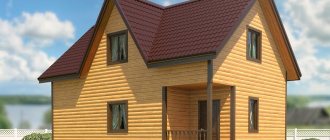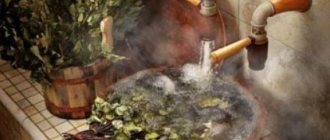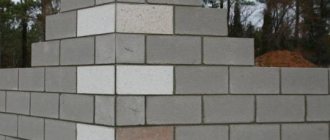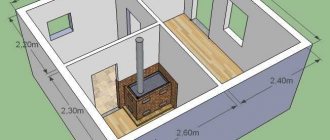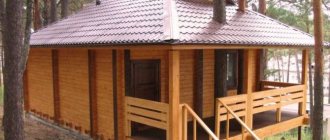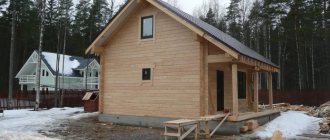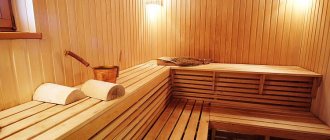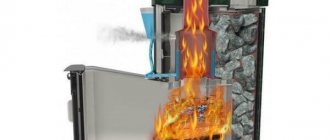Many people choose the frame method of constructing certain structures, including baths, if they cannot build them using solid materials. So, to build a traditional bathhouse from logs and timber, subsequent finishing will be required. But when building a frame bath, you will save significant money, but the appearance of the room will be quite presentable.
In the article you will learn the advantages and disadvantages of this solution, and also read reviews from those who decided to equip a bathhouse from a frame.
Positive and negative in frame baths
A frame bathhouse trimmed with artificial stone looks very presentable.
Frame construction comes to the aid of buyers who want to have a bathhouse or a house on their site, but cannot afford an expensive building. There is a lot of talk about such baths on forums. A large number of positive reviews say that construction has inherent advantages, but there are also disadvantages. We will find out why some of the buildings are criticized below.
Advantages of frame construction of a bathhouse
- All positive reviews about bathhouses with frames are mainly related to their advantages:
- The bathhouse turns out to be light, so the lightest foundation is installed under it.
- When assembled correctly, it retains heat no worse than lumber or logs.
- Construction is carried out in the shortest possible time, along with insulation and finishing.
- The bathhouse will cost from 5,000 rubles/m².
- Assembling a frame bath is 2-3 times faster than a similar one made from timber or brick.
A frame bath is assembled from timber and boards with insulation. The heaviest part of the structure is timber with a section of 100x100 or 150x150 mm. The load on the foundation is ultimately 5–6 times lower, which means there is no need to make it massive.
Disadvantages of frame construction of baths
The frame bath is assembled, but without finishing it does not look aesthetically pleasing.
The negative thing about frame construction is mainly related to costs. Yes, at first glance, such a structure is cheaper. But if you carefully calculate the costs of insulation + finishing (external and internal), then the difference practically disappears. Of course, timber baths also need to be finished over time, but they can simply be painted, and this is cheaper than panels or decorative plastering.
The second big disadvantage of frame construction is poor-quality insulation. If you use inexpensive mineral wool, then you shouldn’t vouch for the beneficial side of the bath. You cannot use inexpensive polystyrene foam, as it is highly flammable.
The third important point is the shrinkage of the bath. It is impossible to leave the insulated frame without finishing for more than 1–2 weeks, and shrinkage can last up to 2 years. Moreover, if you use a beam of natural humidity, then the bathhouse can shrink by 10 cm. In this case, the paneling will crack or become deformed. This can be avoided by building a bathhouse from chamber-drying material, but then the point of saving is lost.
In order to avoid troubles, the frame construction of a bathhouse must be carried out in accordance with all the rules.
When planning construction, you should take into account
- Usually there are one to three people in the bathhouse at the same time, so its area should be at least ten square meters. The dressing room should be slightly smaller in area than the steam room;
- The recommended ceiling height is two meters. If the ceiling is lower, it will be inconvenient. If it is higher, more firewood will be required for heating, or it will be completely impossible to heat it to the required temperature;
- There may be windows in the bathhouse, but they should be very small - no wider than seventy inches and no higher than one hundred and seventy centimeters;
- The door should be smaller than a standard entrance door, slightly higher than one and a half meters and no wider than seventy-five centimeters;
- But the threshold should be high so as not to send cold across the floor when the doors are opened. The optimal threshold height is twenty centimeters.
And most importantly, choose only the highest quality materials for insulation and sheathing. This will guarantee many years of service for your bath. After completion of construction, you can proceed to finishing work immediately. But this does not mean that there will be no shrinkage at all. It will happen within two years. Shrinkage can be even ten centimeters. Therefore, deformation of the finish is almost impossible to avoid. The only thing you can do is to give preference to chamber-drying building materials.
Construction of a frame bath
Since frame construction is lightweight, all work can be done with your own hands. You need to build a frame bath in the following successive steps.
Foundation for a frame bath
Ready-made columnar foundation for a bathhouse with a top frame.
The easiest way to assemble a lightweight foundation for a frame bath is from asbestos-cement pipes (with a diameter of 100 mm or more) reinforced with concrete. This is a columnar type of foundation. The outline of the bathhouse is marked and holes are drilled with a drill to a depth of 1–2 m. The depth depends on the proximity of groundwater and the type of soil.
The pipes are placed in wells and covered with coarse sand. The sand is compacted thoroughly. The entire structure is poured from above with concrete, which should consist of:
1 part waterproof cement M200; 4 parts sand; 7.5 parts of fine crushed stone; 3 parts water.
The pipes are poured one at a time and allowed to dry completely. At the pouring stage, an iron plate is installed on top of each. The first link is subsequently laid on them. Only after this can you make the lower harness.
Installation of the bottom trim
Bottom frame made of timber for a frame bathhouse.
For the bottom trim, you can use a beam with a section of 150x150 mm, but in order to save money, you can take 50x150 boards and join them with self-tapping screws. The entire structure must be treated with an antiseptic and waterproofed before installation. For waterproofing, roofing material is laid on the pillars in 2 layers.
After this, logs for future floors are attached to the harness. Between the lags and the strapping you should also lay roofing material or coat it with mastic.
The piping can be secured to the pipes using special screws or brackets.
Installation of frame walls of a bathhouse
Frame walls of a bathhouse without a rafter system - assembly.
All material, including edged boards, is dried and treated with antiseptics before installation. Instead of timber, you can use the same spliced boards as a basis. They are selected according to the specified dimensions for the racks and rafters.
Assembly is carried out in the following steps:
- Stands are installed in the corners, they are secured together with the top trim.
- Intermediate ones are installed between the racks; they will strengthen the structure.
- The resulting structure is sheathed with boards or particle board using self-tapping screws.
- The remaining racks are installed and also sheathed with boards or OSB.
So, gradually adding links of racks, the entire bathhouse is assembled. In this case, it is necessary to take into account openings for windows and doors; in frame construction they should be made immediately.
Roof installation
Rafter system for the roof of a frame bathhouse made of timber and boards.
The rafter system for a frame bath is installed in parts. Each is assembled at the construction site, gradually lifted and mounted on the roof. Each truss is mounted on its own frame stand. When installing the last truss, OSB is attached to it to create a pediment.
It is more convenient to assemble the roof by first laying rough flooring made of boards on the frame.
It is better to make the roof structure ventilated; for this, a vapor barrier is placed in the gap between the rafters and the counterbeam, and the sheathing is mounted on the beam.
For the roof of a frame bath, it is better to use lightweight material: ondulin, corrugated sheets, soft tiles. After this, the gables are installed using OSB or boards.
Insulation and finishing
Insulation scheme for a frame bath - main layers.
A frame bathhouse must be insulated and finished. Initially, OSB sheets or boards are sewn onto the inside of the ceiling; this will be a rough ceiling. It must be insulated in 3 layers of fire-resistant insulation. The walls are insulated with 2 layers of insulation and glassine. In the steam room, an additional layer of foil insulation is made. Only after this can finishing be done with clapboard or imitation timber.
A stove is installed, which serves as a fireplace in the dressing room and as a heating element in the steam room. To protect the wood of the frame from fire, the partition with a built-in stove is laid out of brick.
Do not forget about ventilation and holes in the ceiling for the pipe. It is treated on all sides with special fire-resistant compounds and lined with iron plates and asbestos paper.
If the bathhouse is built without an attic, then a hatch is made into the attic and additional lighting is installed. The ceiling in the burning room can be lowered to a level of 210 cm, this will make it possible to insulate it and cover it with linden clapboard. It is also better to make all parts in the steam room from linden.
Moisture resistance
Some features of the frame method of building buildings require special attention.
For example, due to high humidity, the floors in the washing room should be made using special technology.
What is unusual is the foundation under this room. The soil under it is removed, and the freed space is filled with sand and gravel to quickly drain water underground without causing damage to the building.
The floor board is laid on logs made of asbestos and cement and pre-filled with concrete mortar. The gap between the joists and boards should be 0.6-0.7 centimeters. Also, rubber gaskets should be placed in this gap.
Bathhouse construction period
Frame construction is considered one of the fastest. But if you compare it with others, it will become clear that the difference is small. Let's look, for comparison, at some stages in tabular form:
| Type of work | Time spent on constructing a bathhouse from various materials, minimum, days | ||
| Frame | timber | Brick | |
| Foundation installation | 3 | 3–4 | 7–10 |
| Installation of piping, joists and wall assembly | 3–4 | 7–10 | 10–20 |
| Installation of rafter system and sheathing | 2 | 2 | 2 |
| Finishing walls and gables | 5–6 | 1 | 1 |
| Insulation and interior finishing | 4–5 | 2–3 | 2–3 |
| Total: | 17–20 | 15–17 | 22–30 |
It turns out that assembling a frame without finishing will be faster than other types, but insulation and finishing will equalize the work period with the installation of a bathhouse made of timber. The price for this will be lower, but the amount of work will be greater.
We have considered all the pros and cons of frame construction. It is up to the owner to decide whether to build a frame bathhouse for permanent use or not. But we recommend using this one for summer cottages or garden plots. It is better to equip residential private houses with baths made of more massive structures.
Bathhouse made of timber: features
Concept
A bathhouse made of timber is a real Russian health resort, caressing with healing aromas, charming beauty and rustic flavor. As a rule, steam rooms are built from:
- ordinary timber, famous for its low price, since it is not pre-treated;
- profiled timber, which is distinguished by a reasonable price and the presence of a recess, which allows the construction of baths without cracks;
- glued laminated timber, which is an ideal raw material for the construction of a bathhouse, as it is subjected to scrupulous processing;
- combined timber, famous not only for its beautiful appearance, but also for its excellent thermal insulation properties.
Building a turnkey sauna from timber is the best investment in the future. Why? Well, now I’ll tell you about the advantages of a wood steam room, and you will understand everything.
Baths made of timber have both advantages and disadvantages. Well, traditionally, we will start with the advantages.
- Aesthetics. The steam rooms look charming.
- Durability. Wooden baths have a service life of more than 70 years.
- Environmental friendliness. The bathhouse is absolutely safe for human health.
- Resistance to the negative influence of climatic factors. Properly made steam rooms are not afraid of high humidity, temperature changes, and precipitation.
- Resistance to the destructive effects of mechanical factors. The structure is not afraid of shocks and loads.
- Resistance to the destructive influence of biological factors. Rodents, insects and microorganisms do not like log steam rooms. How? And like this. The timber is pre-treated with special substances - this is an important point.
- Resistance to thermal factors. High temperatures do not frighten the structure, since the wood is treated with special substances - fire retardants.
- Thermal insulation. The baths warm up with lightning speed, maintain the temperature at the proper level for a long time, and do not release heat.
- No deformation. The bathhouse shrinks, but only slightly, which is why this process does not contribute to the formation of flaws.
- Easy to install. The construction of a bathhouse is simple, but at the same time labor-intensive and time-consuming (compared to a frame one). The steam room takes about 6 months to build and requires a year to shrink.
- Healing. When heated, wood releases substances that have a beneficial effect on the human body (think cedar).
- Economical. The design does not require finishing.
We invite you to familiarize yourself with: Iron stove for a bathhouse diagram
There are almost no disadvantages to a sauna made of timber. Or rather, there are negative aspects, but they are easily eliminated. For example, people are “in love” with wooden baths:
- fire;
- insects;
- microorganisms.
But all this can be “treated” and with proper treatment with special substances, as has already been said, steam rooms made of timber are not afraid of these little things. And, of course, you shouldn’t forget that the price of a clean house is quite high - from 19,000 rubles per square meter.
In general, timber health resorts are true leaders among their peers.
Bathhouse from a gun carriage
